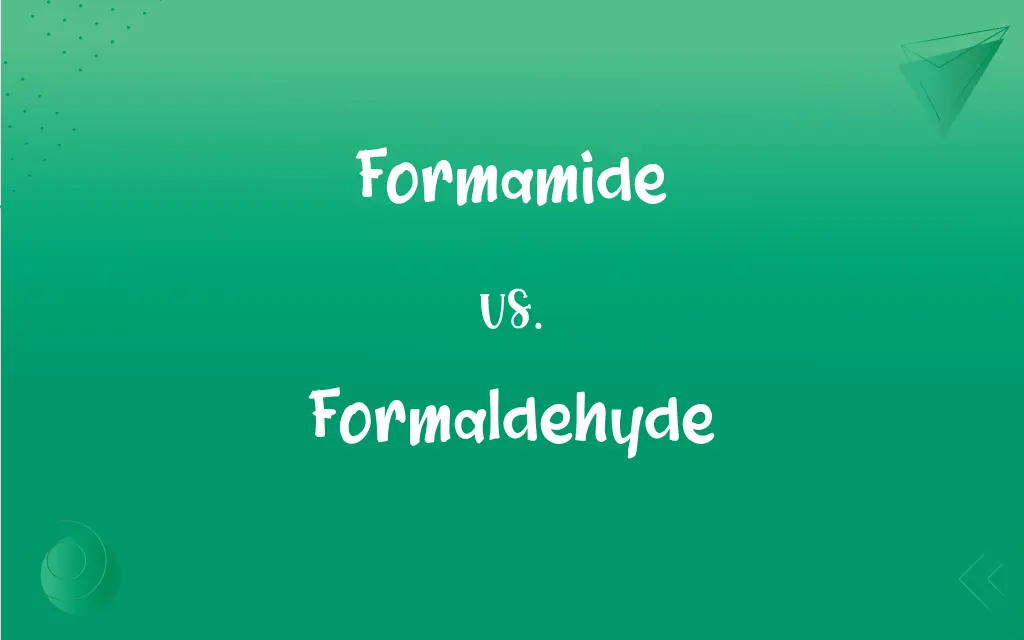Formamide vs. Formaldehyde: What's the Difference?
Edited by Janet White || By Harlon Moss || Published on January 27, 2024
Formamide is a clear liquid used in organic synthesis and as a solvent, while formaldehyde is a colorless gas used as a disinfectant and preservative.

Key Differences
Formamide, with the formula HCONH2, is an amide derived from formic acid, featuring a combination of a carbonyl group and an amine group. In contrast, formaldehyde, having the formula CH2O, is the simplest aldehyde, characterized by a carbon atom double-bonded to oxygen and single-bonded to hydrogen.
Formamide appears as a clear, odorless liquid at room temperature and is miscible with water. Formaldehyde, however, is a colorless gas with a pungent, irritating odor, and is often found in an aqueous solution known as formalin.
Formamide serves as a solvent in pharmaceuticals and is used in the synthesis of other chemicals. Formaldehyde is widely used as a disinfectant, preservative, and in the production of resins and plastics.
Exposure to formamide can cause skin and eye irritation, and it is potentially hazardous if ingested. Formaldehyde is more dangerous, being toxic, carcinogenic, and can cause severe respiratory and skin irritation.
Formamide is biodegradable and poses less threat to the environment. Formaldehyde, however, is a significant indoor air pollutant and poses environmental hazards due to its toxicity and volatility.
ADVERTISEMENT
Comparison Chart
Chemical Formula
HCONH2
CH2O
State at Room Temp.
Liquid
Gas (often in solution)
Odor
Odorless
Pungent, irritating
Main Uses
Solvent, chemical synthesis
Disinfectant, preservative, resin production
Toxicity
Moderate
High (carcinogenic)
ADVERTISEMENT
Formamide and Formaldehyde Definitions
Formamide
Synthesis Intermediate.
In organic synthesis, formamide is an intermediate in various reactions.
Formaldehyde
Chemical Synthesis.
Formaldehyde is involved in the synthesis of various organic compounds.
Formamide
Solvent.
Formamide is used as a solvent in the pharmaceutical industry.
Formaldehyde
Building Material Additive.
Formaldehyde is added to building materials for its preservative qualities.
Formamide
Industrial Chemical.
Industrially, formamide is utilized in the production of various chemicals.
Formaldehyde
Preservative.
Formaldehyde is commonly used as a preservative in biological laboratories.
Formamide
Electrophoresis Medium.
In electrophoresis, formamide helps in analyzing nucleic acids.
Formaldehyde
Disinfectant.
As a disinfectant, formaldehyde sterilizes surgical instruments.
Formamide
DNA/RNA Denaturant.
For molecular biology procedures, formamide denatures DNA and RNA.
Formaldehyde
Resin Component.
In the manufacture of resins, formaldehyde is a key component.
Formamide
(organic compound) The amide of formic acid HCO-NH2 or any N-substituted derivative; they are used in the synthesis of pharmaceuticals
Formaldehyde
A pungent colorless flammable gaseous compound, CH2O, the simplest and most reactive aldehyde, used for manufacturing melamine and phenolic resins, fertilizers, dyes, and embalming fluids and in aqueous solution as a preservative and disinfectant.
Formaldehyde
(organic compound) The simplest aldehyde, HCHO, a colourless gas that has many industrial applications; it dissolves in water to give formol (10%) and formalin.
Formaldehyde
A colorless, volatile liquid, H2CO, resembling acetic or ethyl aldehyde, and chemically intermediate between methyl alcohol and formic acid.
Formaldehyde
A colorless poisonous gas; made by the oxidation of methanol
FAQs
What is formamide?
A clear, odorless liquid used in organic synthesis and as a solvent.
Can formamide be mixed with water?
Yes, it is miscible with water.
Is formamide toxic?
It can be hazardous if ingested and cause skin and eye irritation.
What are the uses of formamide?
Used as a solvent in pharmaceuticals and in chemical synthesis.
How is formaldehyde commonly found?
Often in an aqueous solution known as formalin.
Is formamide biodegradable?
Yes, it poses less threat to the environment.
Can formaldehyde be found in homes?
Yes, in building materials and household products.
What are the dangers of formaldehyde?
It is toxic, carcinogenic, and causes respiratory and skin irritation.
Where is formaldehyde used?
In disinfectants, preservatives, and resin production.
Is formaldehyde used in textiles?
Yes, in the treatment and finishing of fabrics.
Is formamide used in DNA research?
Yes, as a denaturant in molecular biology.
What precautions are necessary when handling formamide?
Use protective gear and proper ventilation.
What is formaldehyde?
A colorless gas used as a disinfectant and preservative.
Are there alternatives to formaldehyde?
Safer chemicals are available but may not be as effective.
How is formamide disposed of?
By following safety guidelines for hazardous chemicals.
How can exposure to formaldehyde be minimized?
Through adequate ventilation and using formaldehyde-free products.
Is formaldehyde an environmental pollutant?
Yes, it's a significant indoor air pollutant.
How does formamide affect health?
Can cause irritation and is potentially toxic if ingested.
Is formamide a natural compound?
It is synthetically produced for industrial use.
What industries rely heavily on formaldehyde?
The building, textile, and plastics industries.
About Author
Written by
Harlon MossHarlon is a seasoned quality moderator and accomplished content writer for Difference Wiki. An alumnus of the prestigious University of California, he earned his degree in Computer Science. Leveraging his academic background, Harlon brings a meticulous and informed perspective to his work, ensuring content accuracy and excellence.
Edited by
Janet WhiteJanet White has been an esteemed writer and blogger for Difference Wiki. Holding a Master's degree in Science and Medical Journalism from the prestigious Boston University, she has consistently demonstrated her expertise and passion for her field. When she's not immersed in her work, Janet relishes her time exercising, delving into a good book, and cherishing moments with friends and family.

































































